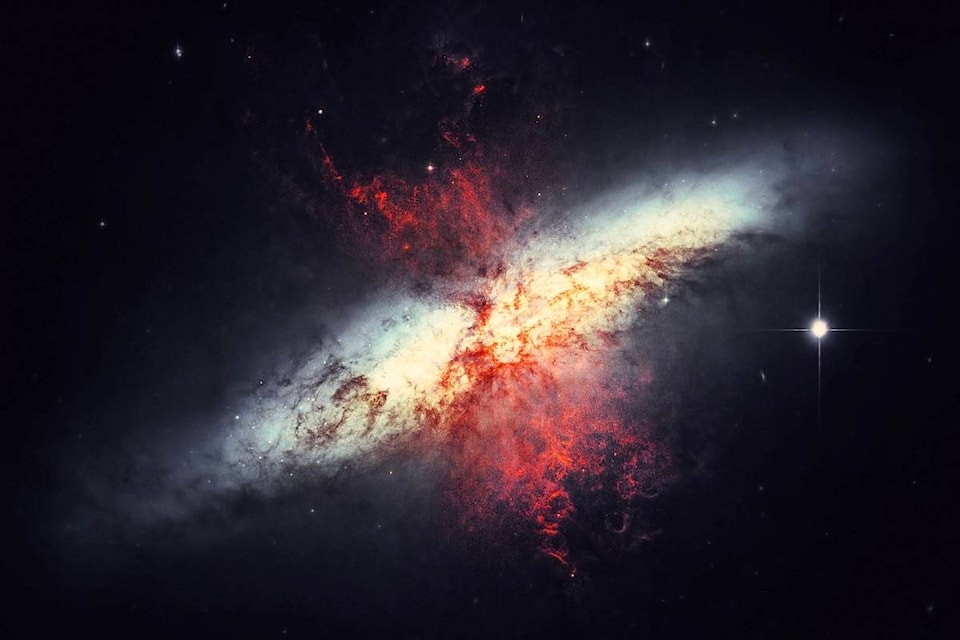The term tidal disruption event, or TDE, must be one of the biggest cosmic euphemisms around. This is what we say is happening when a star is being shredded by a black hole. Imagine something tearing our solar system to pieces: sun, planets, and of course us.
The pull of gravity decreases with distance. As we get higher and higher above the Earth the gravitational attraction decreases, but the effect is slow for small masses like the Earth. Even at the distance of the moon, the force is enough to keep the moon in its orbit and to stop it wandering off into space. However, the Earth’s pull on the moon is a bit stronger on the part of the moon closest to us compared with the other side of the moon. This elongates the moon in our direction by a few metres. Fortunately, the moon’s gravity is strong enough to limit the effect. The moon exerts these tidal forces on the Earth too, pulling the sea up into bumps and giving us the tides. On the other hand, black holes are a different matter. They are extremely massive and highly compact, as we get closer to them, the difference in the gravitational pull between the part of us closer to the black hole and the other side of us becomes enormous, eventually enough to pull us to pieces.
Imagine a star which unfortunately is on a path taking it close to a black hole. As it approaches, the black hole’s pull on the side of the star facing it gets increasingly stronger than its pull on the other side. This difference leads to the star being pulled out of shape, elongating towards the black hole. As long as the star’s own gravity is stronger than this tidal force the star holds together. However, as it approaches, that tidal force increases and the star starts to come apart. First to go are its outer layers, where the gravity holding the star together is weakest. This forms a long streamer, flowing inward toward the black hole. As the star gets closer, more and more of its material gets stripped off, until all that is left are shreds of material streaming into the black hole. This forms a disc around the black hole, referred to, again euphemistically, as an accretion disc, with the black hole continually nibbling away at the inner edge, and more material spiralling inward to replace it. Some of the material pulled off the star gets flung outward, into space.
Fortunately, especially for any inhabitants of planets orbiting around stars, like us, these TDEs are rare, maybe one every several thousand years taking place in our galaxy, the Milky Way. We know of several stars trapped in orbit around the massive black hole in the middle of our galaxy, moving in highly elliptical paths taking them close to the black hole. Their fates are certain but we cannot predict exactly when. However, when it does happen, observers in other galaxies should be able to see the core of our galaxy brighten significantly. This gives us a powerful tool for looking for TDEs in other galaxies and greatly increasing the odds of our seeing one.
These days we have telescopes observing thousands of stars looking for exoplanets, and other telescope networks all over the world monitoring large areas of the sky. On Jan. 29 this year, one of a worldwide network of telescopes caught a TDE happening in another galaxy. The network, known as All-Sky Automated Survey for Supernovae, abbreviated somewhat morbidly as ASASSN, is a set of small (14-centimetre) telescopes at multiple sites around the globe. The event was also picked up by orbiting telescopes.
It is easy to conclude the cosmos is full of catastrophic events. However, most of the universe is much more peaceful, like our solar system. It’s just that catastrophic things liberate lots of energy, which makes them easy to see.
Jupiter and Saturn lie low in the southwest after dark. The moon will be full on Oct. 13.
Ken Tapping is an astronomer with the Dominion Radio Astrophysical Observatory. E-mail: ken.tapping@nrc-cnrc.gc.ca
